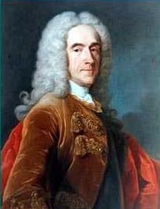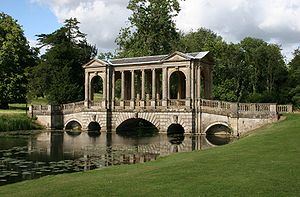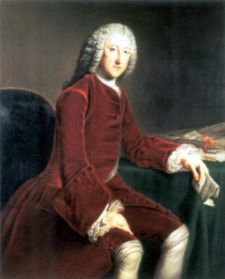
Cobhamites
Encyclopedia

Kingdom of Great Britain
The former Kingdom of Great Britain, sometimes described as the 'United Kingdom of Great Britain', That the Two Kingdoms of Scotland and England, shall upon the 1st May next ensuing the date hereof, and forever after, be United into One Kingdom by the Name of GREAT BRITAIN. was a sovereign...
political faction built around Richard Temple, 1st Viscount Cobham
Richard Temple, 1st Viscount Cobham
Field Marshal Richard Temple, 1st Viscount Cobham PC was a British soldier and Whig politician. He was known for his ownership of and modifications to the estate at Stowe and for serving as a political mentor to the young William Pitt.-Early life:Temple was the son of Sir Richard Temple, 3rd...
and his supporters. Perhaps most notably the group contained the future Prime Ministers William Pitt and George Grenville
George Grenville
George Grenville was a British Whig statesman who rose to the position of Prime Minister of Great Britain. Grenville was born into an influential political family and first entered Parliament in 1741 as an MP for Buckingham...
. They had a general Whig philosiphy and were at first supporters of Prime Minister Sir Robert Walpole but later became opponents of his administration.
Background
The group emerged during the breakdown of the two-party system in Britain when the dominant Whig party had split into several factions - many of whom were in opposition to their fellow Whigs who were in government. Lord Cobham had originally been a supporter of Sir Robert Walpole when he became Prime Minister in 1721, voting with the government in the House of LordsHouse of Lords
The House of Lords is the upper house of the Parliament of the United Kingdom. Like the House of Commons, it meets in the Palace of Westminster....
.
Emergence

Stowe House
Stowe House is a Grade I listed country house located in Stowe, Buckinghamshire, England. It is the home of Stowe School, an independent school. The gardens , a significant example of the English Landscape Garden style, along with part of the Park, passed into the ownership of The National Trust...
in Buckinghamshire. They were a mixture of MPs, Peers as well as some prospective politicians. The writer Alexander Pope
Alexander Pope
Alexander Pope was an 18th-century English poet, best known for his satirical verse and for his translation of Homer. He is the third-most frequently quoted writer in The Oxford Dictionary of Quotations, after Shakespeare and Tennyson...
was associated with the group.
Although almost exclusively made up of Whigs, the group worked closely with the Tories who made up the baulk of the Opposition, and shared Cobham's sharp dislike of the Walpole government. Cobham's supporters and the other Whigs refused to become Tories, and were soon styling themselves as the 'Patriot Party' or 'Patriot Whigs
Patriot Whigs
The Patriot Whigs and, later Patriot Party, was a group within the Whig party in Great Britain from 1725 to 1803. The group was formed in opposition to the ministry of Robert Walpole in the House of Commons in 1725, when William Pulteney and seventeen other Whigs joined with the Tory party in...
'. The group was at times associated with Frederick, Prince of Wales
Frederick, Prince of Wales
Frederick, Prince of Wales was a member of the House of Hanover and therefore of the Hanoverian and later British Royal Family, the eldest son of George II and father of George III, as well as the great-grandfather of Queen Victoria...
a noted opponent of Walpole and his father, the King. The Cobham members would often pay court to Frederick at Leicester House
Leicester House
There have been two mansions in London, England called Leicester House:*A house in the Strand near the Temple: Leicester House, Strand. This existed in the Tudor period, and possibly earlier ....
.
Walpole outraged them further by dismissing all those who held army commissions and had spoken out against him - which they considered an abuse of his powers. The group now set about attacking Walpole in an attempt to force him from office.
Membership

Thomas Pitt of Boconnoc
Thomas Pitt of Boconnoc was the Lord Warden of the Stannaries until 1751, when the Cornish Stannary Parliament last met. He was the grandson and namesake of the better known Thomas Pitt, and the son of Robert Pitt and elder brother of William Pitt the Elder...
for a while also sat with the group, but later broke with them. Other prominent members included Richard Grenville
Richard Grenville
Sir Richard Grenville was an English sailor, sea captain and explorer. He took part in the early English attempts to settle the New World, and also participated in the fight against the Spanish Armada...
, George Grenville
George Grenville
George Grenville was a British Whig statesman who rose to the position of Prime Minister of Great Britain. Grenville was born into an influential political family and first entered Parliament in 1741 as an MP for Buckingham...
, Robert Needham
Robert Needham
Sir Robert Needham was an English politician who sat in the House of Commons from 1645 to 1648.Needham was the son of Thomas Needham of Pool Park and his wife Eleanor Bagenal, daughter of Sir Henry Bagenal and widow of Sir Robert Salisbury. He was knighted on 4 June 1630.In September 1645,...
and George Lyttelton
George Lyttelton, 1st Baron Lyttelton
George Lyttelton, 1st Baron Lyttelton PC , known as Sir George Lyttelton, Bt between 1751 and 1756, was a British politician and statesman and a patron of the arts.-Background and education:...
- many of whom were related to each other either by blood or by marriage. Because of their youth they were popularly known as Cobham's Cubs.
By far the best speaker amongst the group was William Pitt a fact acknowledged even by his opponents who supported the government.
Opposition
Pitt made a series of attacks on Walpole in Parliament, which slowly helped to erode the Prime Minister's authority. Most distressing to the group was the Prime Ministers poor handling of the War of Jenkins' EarWar of Jenkins' Ear
The War of Jenkins' Ear was a conflict between Great Britain and Spain that lasted from 1739 to 1748, with major operations largely ended by 1742. Its unusual name, coined by Thomas Carlyle in 1858, relates to Robert Jenkins, captain of a British merchant ship, who exhibited his severed ear in...
which had broken out in 1739. Walpole was distinctly anti-war and had only reluctantly prosecuted the war - a fact that outraged the pro-war Patriot faction who pushed for his dismissal. Walpole was finally forced into resignation in the wake of the disastrous Siege of Cartagena
Battle of Cartagena de Indias
The Battle of Cartagena de Indias was an amphibious military engagement between the forces of Britain under Vice-Admiral Edward Vernon and those of Spain under Admiral Blas de Lezo. It took place at the city of Cartagena de Indias in March 1741, in present-day Colombia...
and only winning a narrow majority in the 1741 General election.
Having helped to bring Walpole down in 1742 with their fierce attacks on his mishandling of the war with Spain
War of Jenkins' Ear
The War of Jenkins' Ear was a conflict between Great Britain and Spain that lasted from 1739 to 1748, with major operations largely ended by 1742. Its unusual name, coined by Thomas Carlyle in 1858, relates to Robert Jenkins, captain of a British merchant ship, who exhibited his severed ear in...
, the group were equally opposed to the government that followed it, headed officially by Lord Wilmington but in fact led by Lord Carteret. They attacked him, also for his strategic control of the war which they felt placed too much emphasis on fighting in Germany and not enough in waging war with Spain in the Americas. In 1744 they played a part in the end of Carteret's government, to be replaced one led by Henry Pelham
Henry Pelham
Henry Pelham was a British Whig statesman, who served as Prime Minister of Great Britain from 27 August 1743 until his death in 1754...
and his brother the Duke of Newcastle
Duke of Newcastle
Duke of Newcastle-upon-Tyne is a title which has been created three times in British history while the title of Duke of Newcastle-under-Lyne has been created once. The title was created for the first time in the Peerage of England in 1664 when William Cavendish, 1st Marquess of Newcastle-upon-Tyne...
.
Entry into Government

George II of Great Britain
George II was King of Great Britain and Ireland, Duke of Brunswick-Lüneburg and Archtreasurer and Prince-elector of the Holy Roman Empire from 11 June 1727 until his death.George was the last British monarch born outside Great Britain. He was born and brought up in Northern Germany...
disliked him because of repeated criticisms Pitt had made of Hanover. Pitt and the remaining Cobhamites continued to give the government their support for the next few years, and Pitt was finally rewarded by being given the job of Paymaster of the Forces
Paymaster of the Forces
The Paymaster of the Forces was a position in the British government. The office, which was established 1661 after the Restoration, was responsible for part of the financing of the British Army. The first to hold the office was Sir Stephen Fox. Before his time it had been the custom to appoint...
which did not require regular contact with the King.
By the 1750s the group became distinctly displeased with the policies pursued by the Pelhams, and in 1755 they opposed and attacked a government measure regarding a Treaty with Russia, leading to Grenville and Pitt being dismissed and returning to opposition where they continued to attack the Newcastle government.
In 1749 Cobham had died, and the cohesiveness of the group was threatened by the fact that some of his followers were still in government while others were in opposition. Pitt and George Grenville emerged as the effective leaders of the party - which continued to meet at Stowe. In 1756 Pitt led the group into government once more where they were known as the 'Ministry of Cousins' because so many were related. The group then participated in the Second Newcastle Ministry
Second Newcastle Ministry
The Second Newcastle Ministry was a British government which served between 1757 and 1762, at the height of the Seven Years War. It was headed by the Duke of Newcastle, who was serving in his second term as Prime Minister...
which guided Britain to victory in the Seven Years War.
Later Split

Even after the war was concluded with the Peace of Paris in 1763 the split continued with some joining the Grenvillite
Grenvillite
The Grenvillites or Grenvilles were a name given to several British political factions of the 18th and early-19th centuries, all associated with the important Grenville family of Buckinghamshire.-Overview:...
party that held office in 1763 with George Grenville as Prime Minister, while others joined Pitt in opposition. This switched over in 1766 when Pitt became First Minister, and Grenville led his own followers into opposition. The two groups held strikingly opposing views on the issue of America
American Revolution
The American Revolution was the political upheaval during the last half of the 18th century in which thirteen colonies in North America joined together to break free from the British Empire, combining to become the United States of America...
, with Grenville and his supporters holding hawkish views while Pitt preferred conciliation. Pitt and Grenville were eventually able to agree to reconcilliation before the latter's death in 1770.
The sons of Pitt and Grenville and many of their supporters were to form a Pittite party in the 1780s which dominated British politics for a generation.
Prominent members
- Richard Temple, 1st Viscount CobhamRichard Temple, 1st Viscount CobhamField Marshal Richard Temple, 1st Viscount Cobham PC was a British soldier and Whig politician. He was known for his ownership of and modifications to the estate at Stowe and for serving as a political mentor to the young William Pitt.-Early life:Temple was the son of Sir Richard Temple, 3rd...
- William Pitt, 1st Earl of ChathamWilliam Pitt, 1st Earl of ChathamWilliam Pitt, 1st Earl of Chatham PC was a British Whig statesman who led Britain during the Seven Years' War...
- George GrenvilleGeorge GrenvilleGeorge Grenville was a British Whig statesman who rose to the position of Prime Minister of Great Britain. Grenville was born into an influential political family and first entered Parliament in 1741 as an MP for Buckingham...
- Richard Grenville-Temple, 2nd Earl TempleRichard Grenville-Temple, 2nd Earl TempleRichard Grenville-Temple, 2nd Earl Temple KG, PC was a British politician. He is best known for his association with his brother-in-law William Pitt who he served with in government during Britain's participation in the Seven Years War between 1756 and 1761...
- Thomas GrenvilleThomas Grenville (sailor)Thomas Grenville was a British naval officer and Member of Parliament for Bridport. He was born in 1719 the son of Richard Grenville....
- Thomas PittThomas Pitt of BoconnocThomas Pitt of Boconnoc was the Lord Warden of the Stannaries until 1751, when the Cornish Stannary Parliament last met. He was the grandson and namesake of the better known Thomas Pitt, and the son of Robert Pitt and elder brother of William Pitt the Elder...
- George Lyttelton, 1st Baron LytteltonGeorge Lyttelton, 1st Baron LytteltonGeorge Lyttelton, 1st Baron Lyttelton PC , known as Sir George Lyttelton, Bt between 1751 and 1756, was a British politician and statesman and a patron of the arts.-Background and education:...
- Robert NeedhamRobert NeedhamSir Robert Needham was an English politician who sat in the House of Commons from 1645 to 1648.Needham was the son of Thomas Needham of Pool Park and his wife Eleanor Bagenal, daughter of Sir Henry Bagenal and widow of Sir Robert Salisbury. He was knighted on 4 June 1630.In September 1645,...
See also
- Old Corps Whigs
- GrenvilliteGrenvilliteThe Grenvillites or Grenvilles were a name given to several British political factions of the 18th and early-19th centuries, all associated with the important Grenville family of Buckinghamshire.-Overview:...
- Chathamite
- Pittite
- BedforditeBedforditeThe Bedfordites were an 18th century British political faction, led by John Russell, 4th Duke of Bedford. Other than Bedford himself, notable members included John Montagu, 4th Earl of Sandwich; Granville Leveson-Gower, 2nd Earl Gower; Richard Rigby, who served as principal Commons manager for the...
- Rockingham WhigsRockingham WhigsThe Rockingham Whigs or Rockinghamite Whigs in 18th century British politics were a faction of the Whigs led by Charles Watson-Wentworth, 2nd Marquess of Rockingham, when he was the opposition leader in the House of Lords during the government of Lord North from 1770 to 1782 and during the two...

